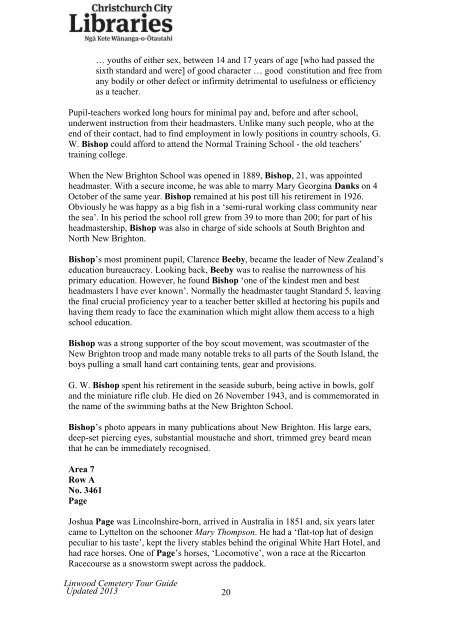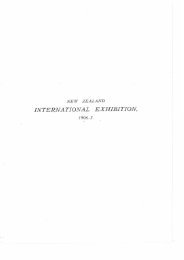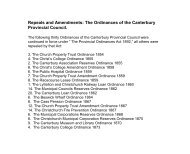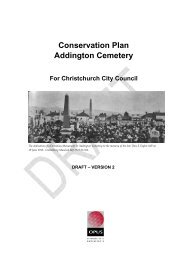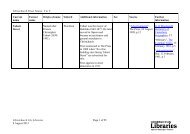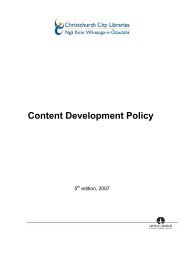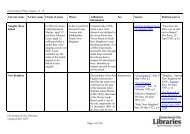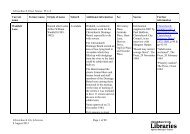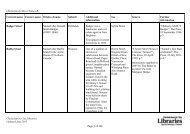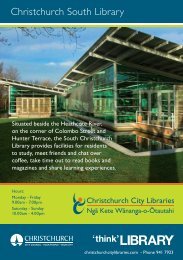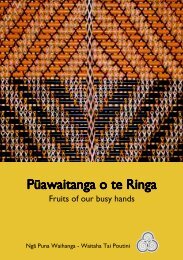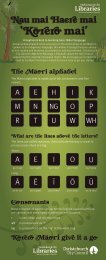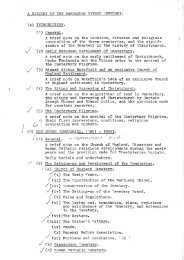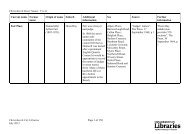Linwood Cemetery Tour Guide - Christchurch City Libraries
Linwood Cemetery Tour Guide - Christchurch City Libraries
Linwood Cemetery Tour Guide - Christchurch City Libraries
Create successful ePaper yourself
Turn your PDF publications into a flip-book with our unique Google optimized e-Paper software.
… youths of either sex, between 14 and 17 years of age [who had passed the<br />
sixth standard and were] of good character … good constitution and free from<br />
any bodily or other defect or infirmity detrimental to usefulness or efficiency<br />
as a teacher.<br />
Pupil-teachers worked long hours for minimal pay and, before and after school,<br />
underwent instruction from their headmasters. Unlike many such people, who at the<br />
end of their contact, had to find employment in lowly positions in country schools, G.<br />
W. Bishop could afford to attend the Normal Training School - the old teachers’<br />
training college.<br />
When the New Brighton School was opened in 1889, Bishop, 21, was appointed<br />
headmaster. With a secure income, he was able to marry Mary Georgina Danks on 4<br />
October of the same year. Bishop remained at his post till his retirement in 1926.<br />
Obviously he was happy as a big fish in a ‘semi-rural working class community near<br />
the sea’. In his period the school roll grew from 39 to more than 200; for part of his<br />
headmastership, Bishop was also in charge of side schools at South Brighton and<br />
North New Brighton.<br />
Bishop’s most prominent pupil, Clarence Beeby, became the leader of New Zealand’s<br />
education bureaucracy. Looking back, Beeby was to realise the narrowness of his<br />
primary education. However, he found Bishop ‘one of the kindest men and best<br />
headmasters I have ever known’. Normally the headmaster taught Standard 5, leaving<br />
the final crucial proficiency year to a teacher better skilled at hectoring his pupils and<br />
having them ready to face the examination which might allow them access to a high<br />
school education.<br />
Bishop was a strong supporter of the boy scout movement, was scoutmaster of the<br />
New Brighton troop and made many notable treks to all parts of the South Island, the<br />
boys pulling a small hand cart containing tents, gear and provisions.<br />
G. W. Bishop spent his retirement in the seaside suburb, being active in bowls, golf<br />
and the miniature rifle club. He died on 26 November 1943, and is commemorated in<br />
the name of the swimming baths at the New Brighton School.<br />
Bishop’s photo appears in many publications about New Brighton. His large ears,<br />
deep-set piercing eyes, substantial moustache and short, trimmed grey beard mean<br />
that he can be immediately recognised.<br />
Area 7<br />
Row A<br />
No. 3461<br />
Page<br />
Joshua Page was Lincolnshire-born, arrived in Australia in 1851 and, six years later<br />
came to Lyttelton on the schooner Mary Thompson. He had a ‘flat-top hat of design<br />
peculiar to his taste’, kept the livery stables behind the original White Hart Hotel, and<br />
had race horses. One of Page’s horses, ‘Locomotive’, won a race at the Riccarton<br />
Racecourse as a snowstorm swept across the paddock.<br />
<strong>Linwood</strong> <strong>Cemetery</strong> <strong>Tour</strong> <strong>Guide</strong><br />
Updated 2013<br />
20


